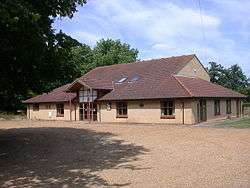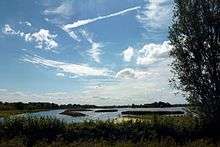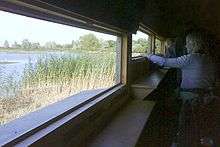Fen Drayton
Fen Drayton is a small village between Cambridge and St. Ives in Cambridgeshire, England, and between the villages of Fenstanton and Swavesey.
| Fen Drayton | |
|---|---|
 Fen Drayton Village Hall | |
 Fen Drayton Location within Cambridgeshire | |
| Population | 856 (2011 Census) |
| OS grid reference | TL335683 |
| District | |
| Shire county | |
| Region | |
| Country | England |
| Sovereign state | United Kingdom |
| Post town | CAMBRIDGE |
| Postcode district | CB24 |
| Dialling code | 01954 |
Much of the working population commutes to work in one of the larger towns or cities nearby, however, there are also a number of farms in the village, some still active.
The village has a primary school, village hall, tennis courts and football fields, where Drayton Lions Football Club play their home matches, and a pub (The Three Tuns). The church (a Church of England) is dedicated to St Mary the Virgin.
The village is close to the A14, the Cambridgeshire Guided Busway and is on National Cycle Route 51.
According to the 2001 census, it is home to 827 people, living in some 329 dwellings. The population was nearly entirely white (99.3%), with 0.4% Asian/Asian British, and 0.4% of mixed ethnicity. 71.5% of the population were Christian, compared to 1.1% listed under 'other religion' (27.4% claimed 'no religion' or did not state a religion). The population of the civil parish as of the 2011 census is856.[1]
Nature reserve


Just north of the village is the Fen Drayton Nature Reserve, a 108-hectare (267-acre) reserve comprising four lakes formed from exhausted sand and gravel pits. These were worked since the 1950s, by ARC (now Hanson plc), and is now a habitat for some 190 bird species, along with other associated wildlife. In particular, gadwall, wigeon, pintail, goldeneye, smew, coot and bittern populations may be seen: it is estimated that 2% of the UK's bittern population, and 4% of the UK's cold weather smew population, reside here, making it an important site. The RSPB purchased much of the site in 2007.[2]
The reserve is accessible from the surrounding villages of Fen Drayton, Swavesey and Fenstanton. It is not accessible from nearby Holywell as Holywell is other side of the River Great Ouse and there is no bridge.
It is open every day (and all day), with no charge, and two car parks, rights of way (footpaths, bridleways and a byway) and hides around the lakes. In times of heavy rain and river flooding, the entire reserve goes under water, including car parks and most rights of way.
The Cambridgeshire Guided Busway passes through the reserve using part of the old Cambridge and Huntingdon railway and the busway was opposed at the planning stage for disturbing this reserve.[3] The route for the guided busway was cleared of vegetation over the winter 2007–2008.
It is planned that the reserve will become part of a much larger wetland area along the River Great Ouse linking to the Hanson-RSPB Wetland Project at Needingworth Quarry that should become Britain's largest reedbed within the next 30 years.[4] This will then connect to reserves at Ouse Washes and Welney north of Earith. The Ouse Washes are managed by the RSPB[5] and Welney is run by the Wildfowl and Wetlands Trust.[6]
In January 2013, following a prolonged period of local flooding, a seal was spotted and filmed in a ditch linked to the nearby Great Ouse, some 50 miles from the sea.[7]
History
Fen Drayton was traditionally an agricultural village, like many in Cambridgeshire, surrounded by fenland. The land is very flat and so it regularly floods.
People from Fen Drayton
George Butler whose family originated in Huntingdon was resident in 1575 at Fen Drayton and had six sons. One of his sons Stephen Butler settled in Belturbet County of Cavan in Kingdom of Ireland and his son Theophilus Butler, was created Baron of Newtownbutler in 1715 his brother Brinsley Butler who succeeded through special remainder was created Viscount Lanesborough in 1728. Viscount Lanesborough's son Humphrey was created Earl of Lanesborough in 1756. The Earldom of Lanesborough became extinct in 1998 on death of Denis Anthony Brian Butler, 9th Earl of Lanesborough.
References
- "Civil Parish population 2011". Neighbourhood Statistics. Office for National Statistics. Retrieved 17 July 2016.
- RSPB: Fen Drayton Lakes nature reserve
- "Cambridgeshire Guided Busway: Inspectors Report". Department for Transport. Archived from the original on 23 October 2008. Retrieved 25 June 2009.
- "Fen Drayton Lakes - Future plans". RSPB. Archived from the original on 11 September 2012. Retrieved 25 June 2008.
- "Ouse Washes". RSPB. Retrieved 25 June 2009.
- "Welney". Wildfowl and Wetlands Trust. Archived from the original on 20 May 2009. Retrieved 25 June 2009.
- "Seal seen at Drayton Lakes Reserve - 50 miles from sea" at bbc.co.uk
External links
| Wikimedia Commons has media related to Fen Drayton. |